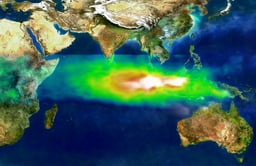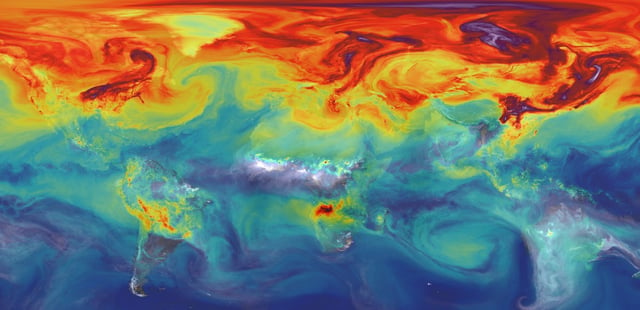Carbon dioxide in Earth's atmosphere
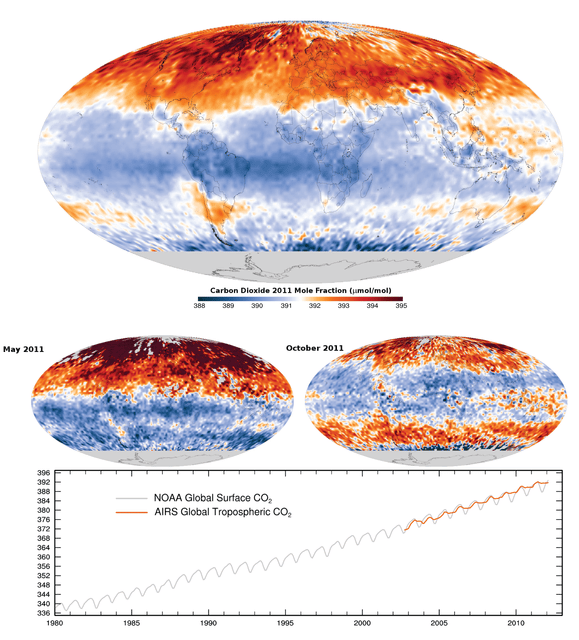
Carbon dioxide in Earth's atmosphere

Mosaic sample of reconstructed CO2 concentrations from 420 million years ago to 1 mya. Full graph with scale in Nature [104] .
Carbon dioxide (CO2) is an important trace gas in Earth's atmosphere. It is an integral part of the carbon cycle, a biogeochemical cycle in which carbon is exchanged between the Earth's oceans, soil, rocks and the biosphere. Plants and other photoautotrophs use solar energy to produce carbohydrate from atmospheric carbon dioxide and water by photosynthesis. Almost all other organisms depend on carbohydrate derived from photosynthesis as their primary source of energy and carbon compounds. CO2 absorbs and emits infrared radiation at wavelengths of 4.26 µm (asymmetric stretching vibrational mode) and 14.99 µm (bending vibrational mode) and consequently is a greenhouse gas that plays a significant role in influencing Earth's surface temperature through the greenhouse effect.[1]
Concentrations of CO2 in the atmosphere were as high as 4,000 parts per million by mass (ppm) during the Cambrian period about 500 million years ago to as low as 180 ppm during the Quaternary glaciation of the last two million years.[2] Reconstructed temperature records for the last 420 million years indicate that atmospheric CO2 concentrations peaked at ~2000 ppm during the Devonian (∼400 Myrs ago) period, and again in the Triassic (220–200 Myrs ago) period. Global annual mean CO2 concentration has increased by more than 45% since the start of the Industrial Revolution, from 280 ppm during the 10,000 years up to the mid-18th century[2] to 415 ppm as of May 2019.[3][4] The present concentration is the highest for 14 million years.[5] The increase has been attributed to human activity, particularly deforestation and the burning of fossil fuels.[6] This increase of CO2 and other long-lived greenhouse gases in Earth's atmosphere has produced the current episode of global warming. Between 30% and 40% of the CO2 released by humans into the atmosphere dissolves into the oceans,[7][8] wherein it forms carbonic acid and effects changes in the oceanic pH balance.
Current concentration

A model of the behavior of carbon in the atmosphere from 1 September 2014 to 31 August 2015. The height of Earth's atmosphere and topography have been vertically exaggerated and appear approximately 40 times higher than normal to show the complexity of the atmospheric flow.

This visualization shows global carbon dioxide concentrations (colored squares) in parts per million by volume (ppmv).
Carbon dioxide concentrations have shown several cycles of variation from about 180 parts per million during the deep glaciations of the Holocene and Pleistocene to 280 parts per million during the interglacial periods. Following the start of the Industrial Revolution, atmospheric CO2 concentration increased to over 400 parts per million and continues to increase, causing the phenomenon of global warming.[9] As of April 2019, the average monthly level of CO2 in Earth's atmosphere exceeded 413 parts per million.[10] The daily average concentration of atmospheric CO2 at Mauna Loa Observatory first exceeded 400 ppm on 10 May 2013[11][12] although this concentration had already been reached in the Arctic in June 2012.[13] As of 2010 it constitutes about 0.041% by volume of the atmosphere, (equal to 410 ppm) [14][15][3][16][17] which corresponds to approximately 3200 billion metric tons of CO2, containing approximately 870 billion metric tons of carbon. Each part per million by volume of CO2 in the atmosphere thus represents approximately 2.13 billion metric tons of carbon.[18] The global mean CO2 concentration is currently rising at a rate of approximately 2 ppm/year and accelerating.[14][19][20] There is an annual fluctuation of about 3–9 ppm which is negatively correlated with the Northern Hemisphere's growing season. The Northern Hemisphere dominates the annual cycle of CO2 concentration because it has much greater land area and plant biomass than the Southern Hemisphere. Concentrations reach a peak in May as the Northern Hemisphere spring greenup begins, and decline to a minimum in October, near the end of the growing season.[20][21]
Since global warming is attributed to increasing atmospheric concentrations of greenhouse gases such as CO2, scientists closely monitor atmospheric CO2 concentrations and their impact on the present-day biosphere. The National Geographic wrote that the concentration of carbon dioxide in the atmosphere is this high "for the first time in 55 years of measurement—and probably more than 3 million years of Earth history."[22] The current concentration may be the highest in the last 20 million years.[23]
Past concentration
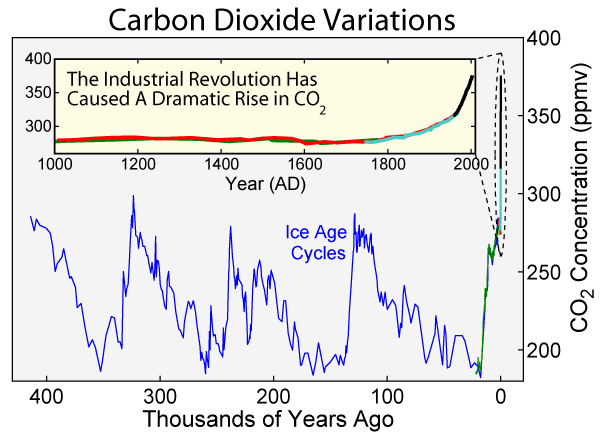
CO2 concentrations over the last 400,000 years
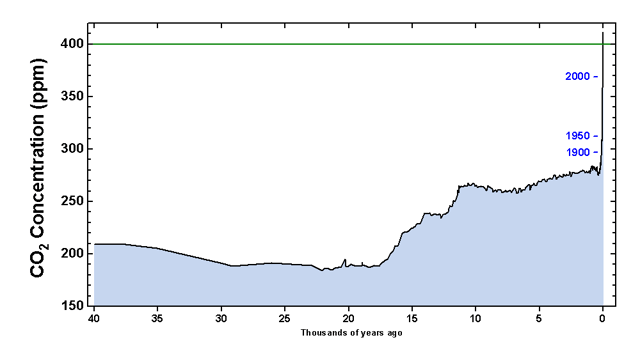
Concentration of atmospheric CO2 over the last 40,000 years, from the Last Glacial Maximum to the present day. The current rate of increase is much higher than at any point during the last deglaciation.
Carbon dioxide concentrations have varied widely over the Earth's 4.54 billion year history. It is believed to have been present in Earth's first atmosphere, shortly after Earth's formation. The second atmosphere, consisting largely of nitrogen and CO2 was produced by outgassing from volcanism, supplemented by gases produced during the late heavy bombardment of Earth by huge asteroids.[24] A major part of carbon dioxide emissions were soon dissolved in water and incorporated in carbonate sediments.
The production of free oxygen by cyanobacterial photosynthesis eventually led to the oxygen catastrophe that ended Earth's second atmosphere and brought about the Earth's third atmosphere (the modern atmosphere) 2.4 billion years before the present. Carbon dioxide concentrations dropped from 4,000 parts per million during the Cambrian period about 500 million years ago to as low as 180 parts per million during the Quaternary glaciation of the last two million years.[2]
Drivers of ancient-Earth carbon dioxide concentration
On long timescales, atmospheric CO2 concentration is determined by the balance among geochemical processes including organic carbon burial in sediments, silicate rock weathering, and volcanism. The net effect of slight imbalances in the carbon cycle over tens to hundreds of millions of years has been to reduce atmospheric CO2. On a timescale of billions of years, such downward trend appears bound to continue indefinitely as occasional massive historical releases of buried carbon due to volcanism will become less frequent (as earth mantle cooling and progressive exhaustion of internal radioactive heat proceed further). The rates of these processes are extremely slow; hence they are of no relevance to the atmospheric CO2 concentration over the next hundreds or thousands of years.
In billion-year timescales, it is predicted that plant, and therefore animal, life on land will die off altogether, since by that time most of the remaining carbon in the atmosphere will be sequestered underground, and natural releases of CO2 by radioactivity-driven tectonic activity will have continued to slow down.[25] The loss of plant life would also result in the eventual loss of oxygen. Some microbes are capable of photosynthesis at concentrations of CO2 of a few parts per million and so the last life forms would probably disappear finally due to the rising temperatures and loss of the atmosphere when the sun becomes a red giant some four billion years from now.[26]
Measuring ancient-Earth carbon dioxide concentration

Graph of CO2 (green), reconstructed temperature (blue) and dust (red) from the Vostok ice core for the past 420,000 years
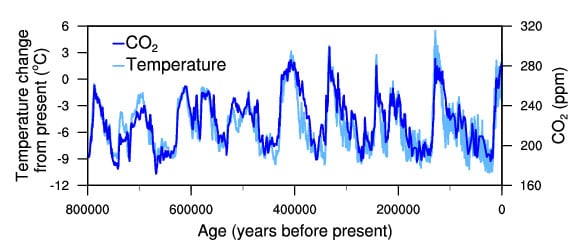
Correspondence between temperature and atmospheric CO2 during the last 800,000 years
The most direct method for measuring atmospheric carbon dioxide concentrations for periods before instrumental sampling is to measure bubbles of air (fluid or gas inclusions) trapped in the Antarctic or Greenland ice sheets. The most widely accepted of such studies come from a variety of Antarctic cores and indicate that atmospheric CO2 concentrations were about 260–280 ppmv immediately before industrial emissions began and did not vary much from this level during the preceding 10,000 years.[27] The longest ice core record comes from East Antarctica, where ice has been sampled to an age of 800,000 years.[28] During this time, the atmospheric carbon dioxide concentration has varied between 180–210 ppm during ice ages, increasing to 280–300 ppm during warmer interglacials.[29][30] The beginning of human agriculture during the current Holocene epoch may have been strongly connected to the atmospheric CO2 increase after the last ice age ended, a fertilization effect raising plant biomass growth and reducing stomatal conductance requirements for CO2 intake, consequently reducing transpiration water losses and increasing water usage efficiency.[31]
There is evidence for high CO2 concentrations between 200 and 150 million years ago of over 3,000 ppm, and between 600 and 400 million years ago of over 6,000 ppm.[23] In more recent times, atmospheric CO2 concentration continued to fall after about 60 million years ago. About 34 million years ago, the time of the Eocene–Oligocene extinction event and when the Antarctic ice sheet started to take its current form, CO2 was about 760 ppm,[34] and there is geochemical evidence that concentrations were less than 300 ppm by about 20 million years ago. Decreasing CO2 concentration, with a tipping point of 600 ppm, was the primary agent forcing Antarctic glaciation.[35] Low CO2 concentrations may have been the stimulus that favored the evolution of C4 plants, which increased greatly in abundance between 7 and 5 million years ago.[32] Based on an analysis of fossil leaves, Wagner et al.[36] argued that atmospheric CO2 concentrations during the last 7,000–10,000 year period were significantly higher than 300 ppm and contained substantial variations that may be correlated to climate variations. Others have disputed such claims, suggesting they are more likely to reflect calibration problems than actual changes in CO2.[37] Relevant to this dispute is the observation that Greenland ice cores often report higher and more variable CO2 values than similar measurements in Antarctica. However, the groups responsible for such measurements (e.g. H.J. Smith et al.[38]) believe the variations in Greenland cores result from in situ decomposition of calcium carbonate dust found in the ice. When dust concentrations in Greenland cores are low, as they nearly always are in Antarctic cores, the researchers report good agreement between measurements of Antarctic and Greenland CO2 concentrations.
Atmospheric carbon dioxide and the greenhouse effect

A pictogram of the greenhouse effect
Earth's natural greenhouse effect makes life as we know it possible and carbon dioxide plays a significant role in providing for the relatively warm temperature that the planet enjoys. The greenhouse effect is a process by which thermal radiation from a planetary atmosphere warms the planet's surface beyond the temperature it would have in the absence of its atmosphere.[39][40][41] Without the greenhouse effect, the Earth's temperature would be about −18 °C (-0.4 °F)[42][43] compared to Earth's actual surface temperature of approximately 14 °C (57.2 °F).[44]
Carbon dioxide is believed to have played an important effect in regulating Earth's temperature throughout its 4.7 billion year history. Early in the Earth's life, scientists have found evidence of liquid water indicating a warm world even though the Sun's output is believed to have only been 70% of what it is today. It has been suggested by scientists that higher carbon dioxide concentrations in the early Earth's atmosphere might help explain this faint young sun paradox. When Earth first formed, Earth's atmosphere may have contained more greenhouse gases and CO2 concentrations may have been higher, with estimated partial pressure as large as 1,000 kPa (10 bar), because there was no bacterial photosynthesis to reduce the gas to carbon compounds and oxygen. Methane, a very active greenhouse gas which reacts with oxygen to produce CO2 and water vapor, may have been more prevalent as well, with a mixing ratio of 10−4 (100 parts per million by volume).[45][46]
Though water is responsible for most (about 36-70%) of the total greenhouse effect, the role of water vapor as a greenhouse gas depends on temperature. On Earth, carbon dioxide is the most relevant, direct anthropologically influenced greenhouse gas. Carbon dioxide is often mentioned in the context of its increased influence as a greenhouse gas since the pre-industrial (1750) era. In the IPCC Fifth Assessment Report the increase in CO2 was estimated to be responsible for 1.82 W·m2 of the 2.63 W·m2 change in radiative forcing on Earth (about 70%).[47]
The concept of atmospheric CO2 increasing ground temperature was first published by Svante Arrhenius in 1896.[48] The increased radiative forcing due to increased CO2 in the Earth's atmosphere is based on the physical properties of CO2 and the non-saturated absorption windows where CO2 absorbs outgoing long-wave energy.
Atmospheric carbon dioxide and the carbon cycle
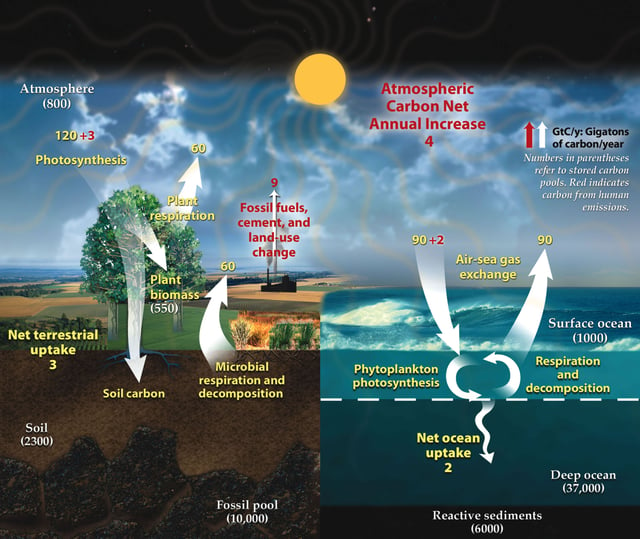
This diagram of the fast carbon cycle shows the movement of carbon between land, atmosphere, and oceans in billions of metric tons of carbon per year. Yellow numbers are natural fluxes, red are human contributions in billions of metric tons of carbon per year. White numbers indicate stored carbon.

Contribution of natural factors and human activities to radiative forcing (RF) of climate change.[49] RF values are for year 2005, relative to pre-industrial (1750).[49] The contribution of solar irradiance to RF is 5% the value of the combined RF due to increases in the atmospheric concentrations of carbon dioxide, methane and nitrous oxide.[50]
Atmospheric carbon dioxide plays an integral role in the Earth's carbon cycle whereby carbon dioxide is removed from the atmosphere by some natural processes such as photosynthesis and deposition of carbonates, to form limestones for example, and added back to the atmosphere by other natural processes such as respiration and the acid dissolution of carbonate deposits. There are two broad carbon cycles on Earth: the fast carbon cycle and the slow carbon cycle. The fast carbon cycle refers to movements of carbon between the environment and living things in the biosphere whereas the slow carbon cycle involves the movement of carbon between the atmosphere, oceans, soil, rocks, and volcanism. Both carbon cycles are intrinsically interconnected and atmospheric gaseous carbon dioxide facilitates the carbon cycle.
Natural sources of atmospheric carbon dioxide include volcanic outgassing, the combustion of organic matter, wildfires and the respiration processes of living aerobic organisms. Man-made sources of carbon dioxide include the burning of fossil fuels for heating, power generation and transport, as well as some industrial processes such as cement making. It is also produced by various microorganisms from fermentation and cellular respiration. Plants, algae and cyanobacteria convert carbon dioxide to carbohydrates by a process called photosynthesis. They gain the energy needed for this reaction from absorption of sunlight by chlorophyll and other pigments. Oxygen, produced as a by-product of photosynthesis, is released into the atmosphere and subsequently used for respiration by heterotrophic organisms and other plants, forming a cycle with carbon.
Most sources of CO2 emissions are natural, and are balanced to various degrees by natural CO2 sinks. For example, the natural decay of organic material in forests and grasslands and the action of forest fires results in the release of about 439 gigatonnes of carbon dioxide every year, while new growth entirely counteracts this effect, absorbing 450 gigatonnes per year.[51] Although the initial carbon dioxide in the atmosphere of the young Earth was produced by volcanic activity, modern volcanic activity releases only 130 to 230 megatonnes of carbon dioxide each year.[52] These natural sources are nearly balanced by natural sinks, physical and biological processes which remove carbon dioxide from the atmosphere. For example, some is directly removed from the atmosphere by land plants for photosynthesis and it is soluble in water forming carbonic acid. There is a large natural flux of CO2 into and out of the biosphere and oceans.[53] In the pre-industrial era these fluxes were largely in balance. Currently about 57% of human-emitted CO2 is removed by the biosphere and oceans.[54][55] From pre-industrial era to 2010, the terrestrial biosphere represented a net source of atmospheric CO2 prior to 1940, switching subsequently to a net sink.[55] The ratio of the increase in atmospheric CO2 to emitted CO2 is known as the airborne fraction (Keeling et al., 1995); this varies for short-term averages and is typically about 45% over longer (5 year) periods.[55] Estimated carbon in global terrestrial vegetation increased from approximately 740 billion tons in 1910 to 780 billion tons in 1990.[56]
Atmospheric carbon dioxide and photosynthesis

Photosynthesis changes sunlight into chemical energy, splits water to liberate O2, and fixes CO2 into sugar.
Carbon dioxide in the Earth's atmosphere is essential to life and to most of the planetary biosphere. Over the course of Earth's geologic history CO2 concentrations have played a role in biological evolution. The first photosynthetic organisms probably evolved early in the evolutionary history of life and most likely used reducing agents such as hydrogen or hydrogen sulfide as sources of electrons, rather than water.[57] Cyanobacteria appeared later, and the excess oxygen they produced contributed to the oxygen catastrophe,[58] which rendered the evolution of complex life possible. In recent geologic times, low CO2 concentrations below 600 parts per million might have been the stimulus that favored the evolution of C4 plants which increased greatly in abundance between 7 and 5 million years ago over plants that use the less efficient C3 metabolic pathway.[32] At current atmospheric pressures photosynthesis shuts down when atmospheric CO2 concentrations fall below 150 ppm and 200 ppm although some microbes can extract carbon from the air at much lower concentrations.[59][60] Today, the average rate of energy capture by photosynthesis globally is approximately 130 terawatts,[61][62][63] which is about six times larger than the current power consumption of human civilization.[64] Photosynthetic organisms also convert around 100–115 thousand million metric tonnes of carbon into biomass per year.[65][66]
Photosynthetic organisms are photoautotrophs, which means that they are able to synthesize food directly from CO2 and water using energy from light. However, not all organisms that use light as a source of energy carry out photosynthesis, since photoheterotrophs use organic compounds, rather than CO2, as a source of carbon.[67] In plants, algae and cyanobacteria, photosynthesis releases oxygen. This is called oxygenic photosynthesis. Although there are some differences between oxygenic photosynthesis in plants, algae, and cyanobacteria, the overall process is quite similar in these organisms. However, there are some types of bacteria that carry out anoxygenic photosynthesis, which consumes CO2 but does not release oxygen.
Carbon dioxide is converted into sugars in a process called carbon fixation. Carbon fixation is an endothermic redox reaction, so photosynthesis needs to supply both the source of energy to drive this process and the electrons needed to convert CO2 into a carbohydrate. This addition of the electrons is a reduction reaction. In general outline and in effect, photosynthesis is the opposite of cellular respiration, in which glucose and other compounds are oxidized to produce CO2 and water, and to release exothermic chemical energy to drive the organism's metabolism. However, the two processes take place through a different sequence of chemical reactions and in different cellular compartments.
Effects of increased CO2 on plants and crops
A 1993 review of scientific greenhouse studies found that a doubling of CO2 concentration would stimulate the growth of 156 different plant species by an average of 37%. Response varied significantly by species, with some showing much greater gains and a few showing a loss. For example, a 1979 greenhouse study found that with doubled CO2 concentration the dry weight of 40-day-old cotton plants doubled, but the dry weight of 30-day-old maize plants increased by only 20%.[69][70]
In addition to greenhouse studies, field and satellite measurements attempt to understand the effect of increased CO2 in more natural environments. In free-air carbon dioxide enrichment (FACE) experiments plants are grown in field plots and the CO2 concentration of the surrounding air is artificially elevated. These experiments generally use lower CO2 levels than the greenhouse studies. They show lower gains in growth than greenhouse studies, with the gains depending heavily on the species under study. A 2005 review of 12 experiments at 475–600 ppm showed an average gain of 17% in crop yield, with legumes typically showing a greater response than other species and C4 plants generally showing less. The review also stated that the experiments have their own limitations. The studied CO2 levels were lower, and most of the experiments were carried out in temperate regions.[71] Satellite measurements found increasing leaf area index for 25% to 50% of Earth's vegetated area Earth over the past 35 years, providing evidence for a positive CO2 fertilization effect.[72][73]
A 2017 Politico article states that increased CO2 levels may have a negative impact on the nutritional quality of various human food crops, by increasing the levels of carbohydrates, such as glucose, while decreasing the levels of important nutrients such as protein, iron, and zinc. Crops experiencing a decrease in protein include rice, wheat, barley and potatoes.[74]
Atmospheric carbon dioxide and the oceanic carbon cycle

Air-sea exchange of CO2
The Earth's oceans contain a large amount of CO2 in the form of bicarbonate and carbonate ions—much more than the amount in the atmosphere. The bicarbonate is produced in reactions between rock, water, and carbon dioxide. One example is the dissolution of calcium carbonate:
- CaCO
- 2
3
2
2O⇌Ca2+
3
Reactions like this tend to buffer changes in atmospheric CO2. Since the right side of the reaction produces an acidic compound, adding CO2 on the left side decreases the pH of seawater, a process which has been termed ocean acidification (pH of the ocean becomes more acidic although the pH value remains in the alkaline range). Reactions between CO2 and non-carbonate rocks also add bicarbonate to the seas. This can later undergo the reverse of the above reaction to form carbonate rocks, releasing half of the bicarbonate as CO2. Over hundreds of millions of years, this has produced huge quantities of carbonate rocks.
Ultimately, most of the CO2 emitted by human activities will dissolve in the ocean;[75] however, the rate at which the ocean will take it up in the future is less certain. Even if equilibrium is reached, including dissolution of carbonate minerals, the increased concentration of bicarbonate and decreased or unchanged concentration of carbonate ion will give rise to a higher concentration of un-ionized carbonic acid and dissolved CO2. This, along with higher temperatures, would mean a higher equilibrium concentration of CO2 in the air.
Anthropogenic CO2 emissions
While CO2 absorption and release is always happening as a result of natural processes, the recent rise in CO2 levels in the atmosphere is known to be mainly due to human (anthropogenic) activity.[80] There are four ways human activity, especially fossil fuel burning, is known to have caused the rapid increase in atmospheric CO2 over the last few centuries. 1) Various national statistics accounting for fossil fuel consumption, combined with knowledge of how much atmospheric CO2 is produced per unit of fossil fuel (e.g. liter of gasoline).[81] 2) By examining the ratio of various carbon isotopes in the atmosphere.[80] The burning of long-buried fossil fuels releases CO2 containing carbon of different isotopic ratios to those of living plants, enabling distinction between natural and human-caused contributions to CO2 concentration. 3) Higher atmospheric CO2 concentrations in the Northern Hemisphere, where most of the world's population lives (and emissions originate from), compared to the southern hemisphere. This difference has increased as anthropogenic emissions have increased.[82] 4) Atmospheric O2 levels are decreasing in Earth's atmosphere as it reacts with the carbon in fossil fuels to form CO2.[83]
Burning fossil fuels such as coal, petroleum, and natural gas is the leading cause of increased anthropogenic CO2; deforestation is the second major cause. In 2010, 9.14 gigatonnes of carbon (GtC, equivalent to 33.5 gigatonnes of CO2 or about 4.3 ppm in Earth's atmosphere) were released from fossil fuels and cement production worldwide, compared to 6.15 GtC in 1990.[84] In addition, land use change contributed 0.87 GtC in 2010, compared to 1.45 GtC in 1990.[84] In 1997, human-caused Indonesian peat fires were estimated to have released between 13% and 40% of the average carbon emissions caused by the burning of fossil fuels around the world in a single year.[85][86][87] In the period 1751 to 1900, about 12 GtC were released as CO2 to the atmosphere from burning of fossil fuels, whereas from 1901 to 2013 the figure was about 380 GtC.[88]
Anthropogenic carbon emissions exceed the amount that can be taken up or balanced out by natural sinks.[89] As a result, carbon dioxide has gradually accumulated in the atmosphere, and as of 2019, its concentration is almost 48% above pre-industrial levels.[12] Various techniques have been proposed for removing excess carbon dioxide from the atmosphere in carbon dioxide sinks. Currently about half of the carbon dioxide released from the burning of fossil fuels is not absorbed by vegetation and the oceans and remains in the atmosphere.[90]
Excess CO2 emitted since the pre-industrial era is projected to remain in the atmosphere for centuries to millennia,[91] even after emissions stop. Even if human carbon dioxide emissions were to completely cease, atmospheric temperatures are not expected to decrease significantly for thousands of years.[92]
Ongoing measurements of atmospheric CO2
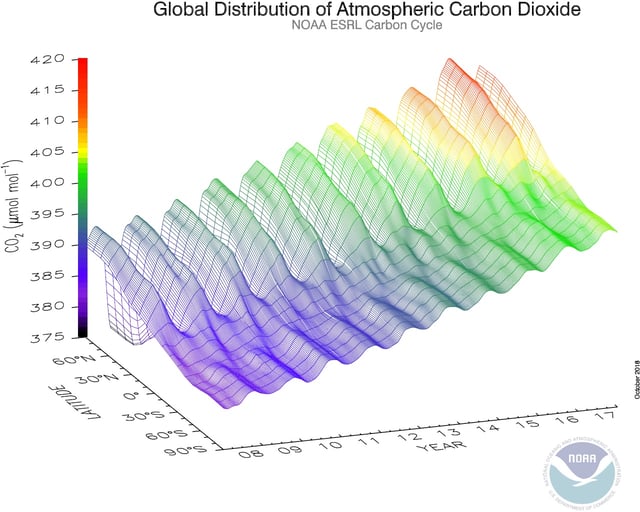
Carbon Dioxide observations from 2005 to 2014 showing the seasonal variations and the difference between northern and southern hemispheres
The first reproducibly accurate measurements of atmospheric CO2 were from flask sample measurements made by Dave Keeling at Caltech in the 1950s.[93] A few years later in March 1958 the first ongoing measurements were started by Keeling at Mauna Loa. Measurements at Mauna Loa have been ongoing since then. Now measurements are made at many sites globally. Additional measurement techniques are also used as well. Many measurement sites are part of larger global networks. Global network data are often made publicly available on the conditions of proper acknowledgment according to the respective data user policies.
There are several surface measurement (including flasks and continuous in situ) networks including NOAA/ERSL,[94] WDCGG,[95] and RAMCES.[96] The NOAA/ESRL Baseline Observatory Network, and the Scripps Institution of Oceanography Network [97] data are hosted at the CDIAC at ORNL. The World Data Centre for Greenhouse Gases (WDCGG), part of GAW, data are hosted by the JMA. The Reseau Atmospherique de Mesure des Composes an Effet de Serre database (RAMCES) is part of IPSL.
From these measurements, further products are made which integrate data from the various sources. These products also address issues such as data discontinuity and sparseness. GLOBALVIEW-CO2 is one of these products.[98]
Ongoing ground-based total column measurements began more recently. Column measurements typically refer to an averaged column amount denoted XCO2, rather than a surface only measurement. These measurements are made by the TCCON. These data are also hosted on the CDIAC, and made publicly available according to the data use policy.[99]
Satellite measurements are also a recent addition to atmospheric XCO2 measurements. SCIAMACHY aboard ESA's ENVISAT made global column XCO2 measurements from 2002–2012. AIRS aboard NASA's Aqua satellite makes global XCO2 measurements and was launched shortly after ENVISAT in 2012. More recent satellites have significantly improved the data density and precision of global measurements. Newer missions have higher spectral and spatial resolutions. JAXA's GOSAT was the first dedicated GHG monitoring satellite to successfully achieve orbit in 2009. NASA's OCO-2 launched in 2014 was the second. Various other satellites missions to measure atmospheric XCO2 are planned.
See also
Atmospheric carbon cycle
Carbon cycle
Global temperature record
Keeling Curve


